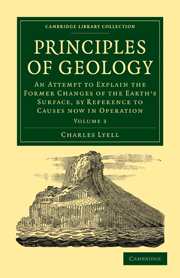 Principles of Geology
Principles of Geology Book contents
- Frontmatter
- PREFACE
- Contents
- LIST OF PLATES AND WOOD-CUTS IN THE THIRD VOLUME
- LIST OF WOOD-CUTS
- ERRATA
- CHAPTER I
- CHAPTER II
- CHAPTER III
- CHAPTER IV
- CHAPTER V
- CHAPTER VI
- CHAPTER VII
- CHAPTER VIII
- CHAPTER IX
- CHAPTER X
- CHAPTER XI
- CHAPTER XII
- CHAPTER XIII
- CHAPTER XIV
- CHAPTER XV
- CHAPTER XVI
- CHAPTER XVII
- CHAPTER XVIII
- CHAPTER XIX
- CHAPTER XX
- CHAPTER XXI
- CHAPTER XXII
- CHAPTER XXIII
- CHAPTER XXIV
- CHAPTER XXV
- CHAPTER XXVI
- Table I Showing the relations of the various classes of rocks, the Alluvial, the Aqueous, the Volcanic, and the Hypogene, of different periods
- Table II Showing the order of superposition of the principal European groups of sedimentary strata mentioned in this work
- Notes in explanation of the Tables of fossil shells in Appendix I
- Appendix I Tables of fossil shells by Monsieur G. P. Deshayes
- Appendix II Lists of fossil Shells chiefly collected by the author in Sicily and Italy, named by M. Deshayes
- Glossary, containing an explanation of geological and other scientific terms used in this work
- Index
- WORKS ON SCIENCE AND NATURAL HISTORY
- Plate section
- Frontmatter
- PREFACE
- Contents
- LIST OF PLATES AND WOOD-CUTS IN THE THIRD VOLUME
- LIST OF WOOD-CUTS
- ERRATA
- CHAPTER I
- CHAPTER II
- CHAPTER III
- CHAPTER IV
- CHAPTER V
- CHAPTER VI
- CHAPTER VII
- CHAPTER VIII
- CHAPTER IX
- CHAPTER X
- CHAPTER XI
- CHAPTER XII
- CHAPTER XIII
- CHAPTER XIV
- CHAPTER XV
- CHAPTER XVI
- CHAPTER XVII
- CHAPTER XVIII
- CHAPTER XIX
- CHAPTER XX
- CHAPTER XXI
- CHAPTER XXII
- CHAPTER XXIII
- CHAPTER XXIV
- CHAPTER XXV
- CHAPTER XXVI
- Table I Showing the relations of the various classes of rocks, the Alluvial, the Aqueous, the Volcanic, and the Hypogene, of different periods
- Table II Showing the order of superposition of the principal European groups of sedimentary strata mentioned in this work
- Notes in explanation of the Tables of fossil shells in Appendix I
- Appendix I Tables of fossil shells by Monsieur G. P. Deshayes
- Appendix II Lists of fossil Shells chiefly collected by the author in Sicily and Italy, named by M. Deshayes
- Glossary, containing an explanation of geological and other scientific terms used in this work
- Index
- WORKS ON SCIENCE AND NATURAL HISTORY
- Plate section
Summary
SECONDARY FORMATIONS.
As we have already exceeded the limits originally assigned to this work, it is not our intention to enter, at present, upon a detailed description of the formations usually called ‘Secondary,’ the elucidation of which might well occupy another volume. By ‘secondary,’ we mean those stratified rocks older than the tertiary, which contain distinct organic remains, and which sometimes pass into the strata called ‘Primary’, to be described in our concluding chapters.
The observations which we are about to offer have chiefly for their object to show that the rules of interpretation adopted by us for the tertiary formations, are equally applicable to the phenomena of the secondary series. This last has been divided into several groups, and we shall briefly enumerate some of the principal of these for the convenience of reference, without pretending to offer to the student a systematic classification, founded on a full comparison of fossil remains.
PRINCIPAL SECONDARY GROUPS. (Descending Series.)
Strata from the chalk of Maestricht to the lower greensand inclusive.
The number of species of testacea already procured from the different members of this division amount to about 1000. The principal subdivisions are the Maestricht beds, the chalk with and without flints, the upper green-sand, the gault, and the lower green-sand. The first of these groups is seen at St. Peter's Mount, Maestricht, reposing upon the upper flinty chalk of England and France. It is characterized by a peculiar assemblage of organic remains, perfectly distinct from those of the tertiary period.
- Type
- Chapter
- Information
- Principles of GeologyAn Attempt to Explain the Former Changes of the Earth's Surface, by Reference to Causes now in Operation, pp. 324 - 336Publisher: Cambridge University PressPrint publication year: 2009First published in: 1833
